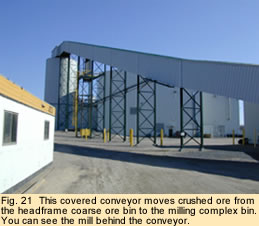About the Red Lake Mine and Specimen Recovery
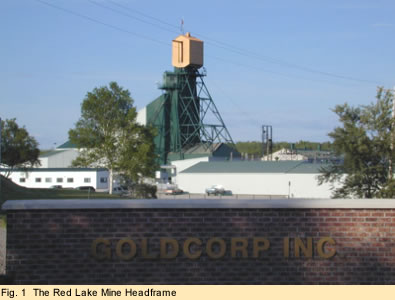
General
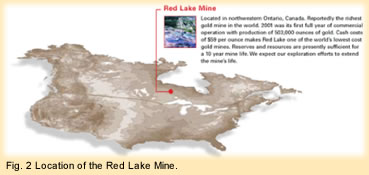
The Red Lake Mine, owned by Goldcorp Inc., of Toronto, Ontario, Canada, is, currently, the highest grade gold mine in the world. The mine has operated since the 1940’s but little is left of the old orebodies. All current mining is accomplished in the “High Grade Zone”, discovered in 1995. The mining operations produce about 600 tons per day at a mill-head grade of, currently, well over 2.0 ounces per ton. The High Grade Zone(Nov., 2002) consists of 1.85 million tons (proven and probable) of ore grading 2.05 troy ounces per ton. At current mining rates, there is enough ore to sustain the mill for over 10 years at the current mining/milling rates. In 2001, 503,385 troy ounces of gold were recovered at the Red Lake Mine!
Goldcorp Inc. has taken the unusually progressive step of preserving native gold specimens. It would be easy for Goldcorp Inc. to simply mill all of the gold ore in the mine, pour it into gold bars and sell it as gold bullion. Instead, Goldcorp Inc. realized that gold specimens are rare in nature. They are natural, beautiful sculptures of a relatively rare mineral. Gold is a special mineral in that, like few others, it has a high intrinsic value, in addition to its value as a mineral specimen. A gold specimen is a very worthwhile keepsake that is a timeless legacy of nature at work in forming the Red Lake Mine orebody.
The Geology of the Red Lake Mine
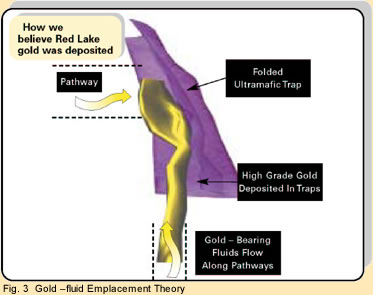
The Red Lake mine is located in the Red Lake greenstone belt that consists of a typical Archean sequence of metavolcanic and metasedimentary rocks.
Gold occurs in the Balmer assemblage (2992-2958 my) which occupies the core of the above sequence. The gold deposits of Red Lake area are an example of the 'Archean Load Gold' model. Goldcorp geologists believe that gold bearing hydrothermal solutions percolating through fracture systems in altered volcanic rocks were “trapped” by intrusions of ultramafic rocks that acted as dams, thus concentrating the gold bearing solutions. These hydrothermal solutions eventually solidified into the gold bearing mineralization that we now see in place in the High Grade Zone at the Red Lake Mine.
The Mineralogy of the High Grade Zone
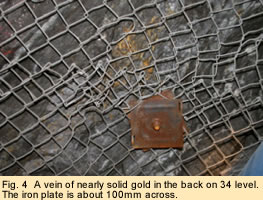
In general, the gold mineralization at the Red Lake Mine is present as native gold that is often visible. On occasion, extremely high grade zones are encountered where localized grades of the ore run in the thousands of ounces per ton. This is where the gold specimens are found. Those zones are an awesome sight to behold!!
Native gold abounds as thick, dense clots, rich zones of particles and as coarse plates and leaves. The platey and leaf-like habits of gold provide the best mineral specimens since the leaves and plates protrude from the rock matrix in aesthetically pleasing combinations.
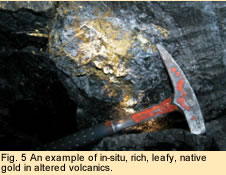
The gold is really the only mineral that occurs in museum/collector quality specimens, often associated with pyrrhotite and pyrite. There are occasional zones rich with massive stibnite, berthierite, chalcopyrite, sphalerite, arsenopyrite, magnetite and other common metallic minerals impregnated with native gold that make handsome and interesting specimens but there really are no excellent specimens of these species. Having said that, there have been numerous very rare species noted in polished section work aimed at understanding the mineralization better. A list of the possible other minerals determined mostly by chemistry, only include: electrum, boulangerite, zoubekite, hessite, tetrahedrite, benleonardite, ullmanite, pentlandite, gersdorffite, gudmundite, aurostibite, bournonite, lollingite, etc. Perhaps we’ll find some of the rarer ones in large or crystallized specimens some time!!?
The non-metallic “gangue” minerals are usually composed of white,grey or black quartz, tourmaline, mica, carbonate(iron-rich), sericite and the minerals that compose the altered volcanics, one of the more common rocks hosting the gold mineralization.
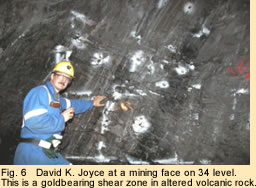
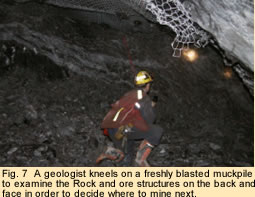
Specimen Recovery

Specimen recovery is largely accomplished by mine “beat” geologists and the miners who work on their beats. Each geologist at the mine has a section of the mine that is his or her “beat” that they are responsible for. They travel their mine beat regularly, noting geology, mapping, marking up the ore zones for the miners and taking samples to determine and monitor the grades in each stope or working place.
When geologists or miners detect very high grade ore, ie., massive or very obvious leafy gold in the ore, they isolate some of the material for movement to surface. This specimen-potential ore is placed in locked aluminum boxes, usually in sample bags that record the location in the mine where the samples
originated.
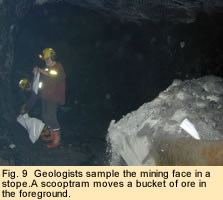

The boxes are then moved to the main levels by miners and taken up the shaft in the cage. The locked boxes are moved to safe storage, on surface and eventually to the vault for processing.


Specimen Preparation
Periodically, David K. Joyce visits the mine and works under the constantly watchful eyes of the mine security guards to break open the large rough pieces of gold bearing rock to better expose the gold.

His experience with gold and other minerals over 19 or so years in the business and for 35 years as a private collector have enabled him to understand the aesthetics and the associations of gold as mineral specimens that make them interesting and beautiful. He uses mechanical breakers, hammers and chisels to crack and pry away barren rock, in order to expose the relatively rare and beautiful leafy or coarse gold to best effect. Most of the gold specimens are prepared in this way.
In some specimens, the gold remains obscured by stubborn quartz or carbonates and these warrant further treatment. They are immersed in either hydrochloric or hydrofluoric acid in the mill laboratory facilities. These sorts of specimens are the minority, however.
The hydrochloric acid is used to remove the carbonates from a specimen. The hydrofluoric acid is used to leach away solid quartz and some other minerals. Sometimes, parts of a specimen are “masked” with a protective covering to keep the acid away from important parts of the specimen. That way, just part of the specimen is selectively etched while leaving the rest of the specimen in its natural “as found” state. This technique can expose the beautiful gold nicely while preserving the informative mineralogy/geology of the rest of the specimen.
Gold Content Determination
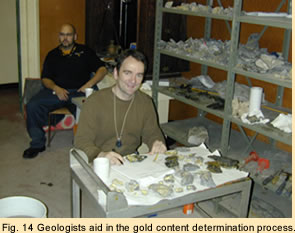
Each specimen is evaluated to determine its gold content. These measurements are necessary to determine the gold content to ensure that each specimen is not sold at a price less than the intrinsic value of the gold that it contains. The specimens that can be sold at a premium price over their gold content value are offered for sale to collectors, museums and other institutions. If the specimen cannot be sold at a premium over gold content, then it is reworked so that it can be sold or is simply sent to the mill so that the gold can be recovered from it. It takes a considerable effort to recover specimen grade ore, process it, measure it and sell it , so a premium is an absolute necessity to ensure that the specimen enterprise is viable.

The gold determination is accomplished using the age old “Archimedes principle” of determining the density of the specimen by weighing in air and water and then comparing the relative weights to the volume of water that it displaces. Combined with a factor considering the density of the gangue mineral and the well known density of gold itself (19.2 times the density of water!!), this is an accurate method of determining the actual gold content of a specimen.


Sales of Gold Specimens
Specimens are offered for sale on David K. Joyce’s website which can be accessed directly at www.djoyceminerals.com or through a link from Goldcorp Inc.’s fantastic website at www.goldcorp.com. As well, Specimens are sold at a limited number of shows such as the Denver and Tucson Gem and Mineral shows. Hundreds of specimens, each unique, have found their way into institutional and private collections around the world over the past couple of years.
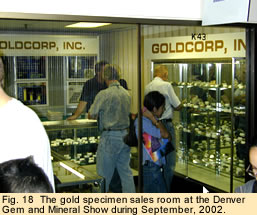
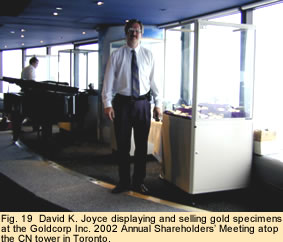
General
Here are some views of the Red Lake Mine to help you visualize this magnificent new mine.

